Recent Articles
Popular Makes
Body Types
2021 Ford Edge vs 2021 Hyundai Santa Fe
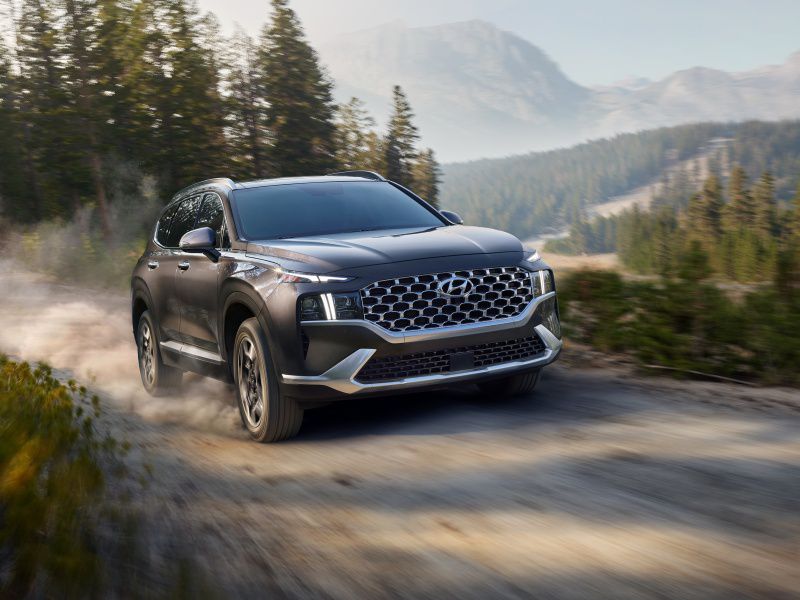
2021 Hyundai Santa Fe HEV ・ Photo by Hyundai
Many people seek out a mid-size SUV for the ability to transport more than five passengers; however, there are buyers who aren't solely passenger-focused. Instead, for these buyers, a mid-size crossover's upright stance, elevated driving position, and large cargo hold are the bigger draws. And many of these folks are looking for a vehicle that is more stylish than the typical multi-passenger people-haulers. The Ford Edge has always been a leading example of a mid-size crossover SUV, and more recently, the Hyundai Santa Fe has joined the fray. The Santa Fe’s design overhaul for the 2021 model year has upped its visual appeal considerably. In overall size and interior accommodations, it matches up well with the Edge, and it offers hybrid trims that the Edge does not. One way the Edge makes up for this is with a standard infotainment screen that, in competitive terms, is gigantic. Both vehicles bring a long list of positives to this comparison. Here is the comparison of the 2021 Ford Edge and the 2021 Hyundai Santa Fe.
Exterior Style
One of the key selling points of the Ford Edge is its good looks. The 2021 Edge is built on a veteran platform, but Ford has given it a recent restyle that keeps it contemporary. In contrast, the Hyundai Santa Fe hasn’t leaned on exterior style as one of its keystones, but for the 2021 model year, Hyundai has given the vehicle a makeover that improves its exterior aesthetic considerably. The attractive front end of the Edge features the Ford oval in the middle of a well-drawn prominent grille opening. Its roofline balances interior space with swoopy design. For those who desire an extra dollop of sportiness, the new Edge ST-Line uses many of the styling features of the performance-oriented ST trim level. The Hyundai Santa Fe’s facelift includes a rich-looking front grille flanked by headlights and driving lights. Overall, the new look makes it much more competitive with the Ford Edge.
: Ford Edge
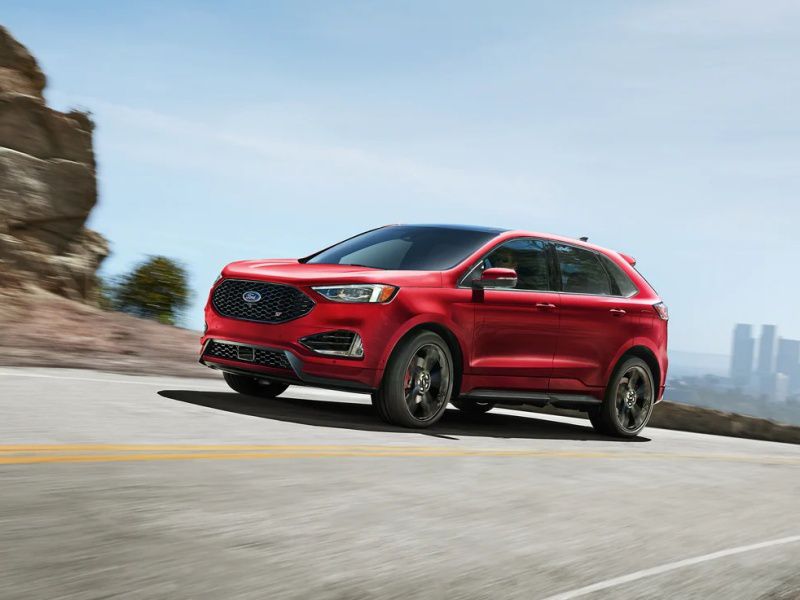
Interior Design
In a segment that emphasizes style, interior design is very important. Both the 2021 Ford Edge and the 2021 Hyundai Santa Fe offer interiors that give equal weight to looks and convenience. When one analyzes the interior of the Edge, you can’t help but be impressed by the 12-inch infotainment display screen that dominates the interior. Placed with a vertical orientation, the screen, much like the screen in the F-150 pickup, can be divided into sections, enabling drivers to specify the information they’d like to see up front. The Edge’s instruments are quite visible through the steering wheel, and the controls in the center of the dash are simple and easy to understand. The base SE grade offers cloth front buckets, and leather seats are standard in the top-level Titanium Elite and the performance Edge ST. The Hyundai Santa Fe counters the Edge’s high-style interiors with its own flair. The Santa Fe’s all-new, top-of-the-line Calligraphy trim level has upscale features including leather seats, a panoramic sunroof, and a 10.25-inch infotainment display.
: Tie
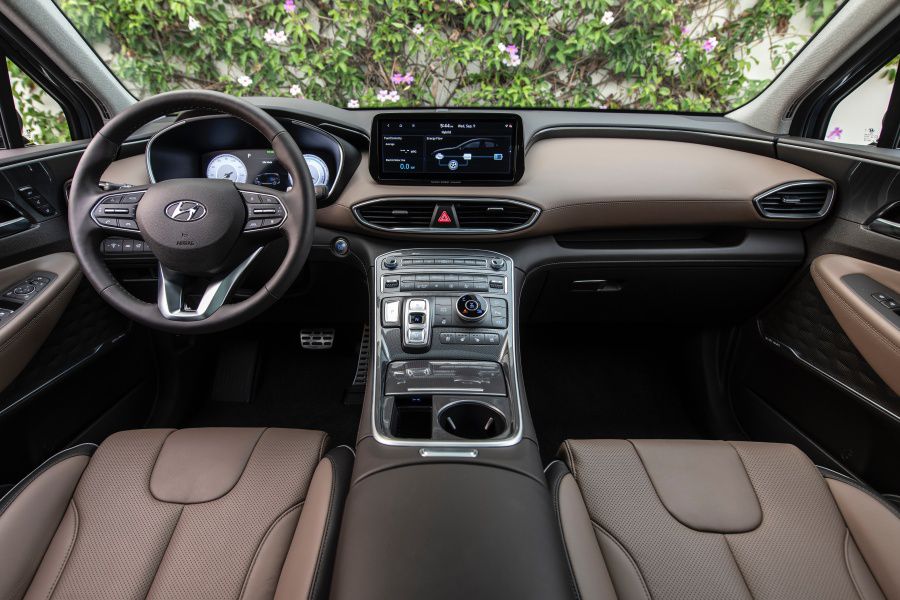
Photo by Hyundai
Infotainment Features
Hyundai has always provided solid, easy-to-use infotainment systems, and the tradition continues in the 2021 Hyundai Santa Fe. Depending upon the trim level, the Santa Fe is equipped with an 8- or 10.25-inch infotainment displays. Android Auto and Apple CarPlay are standard across the board. The 8-inch display systems have standard wireless Apple CarPlay and Android Auto, but the 10.25-inch system doesn’t offer those apps wirelessly. Wireless phone charging is available on the upscale Limited and Calligraphy trim levels, though.
The Santa Fe’s top trims also have a standard 630-watt Harman/Kardon premium audio system. While the Santa Fe’s offerings are impressive, they might be outclassed by the Ford Edge. Its 12-inch touchscreen infotainment is standard across the lineup. The SYNC 4A system that powers it has good voice recognition capabilities and offers wireless Apple CarPlay and Android Auto. In addition, most Edge trims have a 6-speaker audio system with Sirius XM and speed-compensating volume, while the ST and Titanium Elite trims are equipped with a 12-speaker B&O sound system by Bang & Olufsen. The standard FordPass Connect system includes a Wi-Fi hotspot that can connect up to 10 devices.
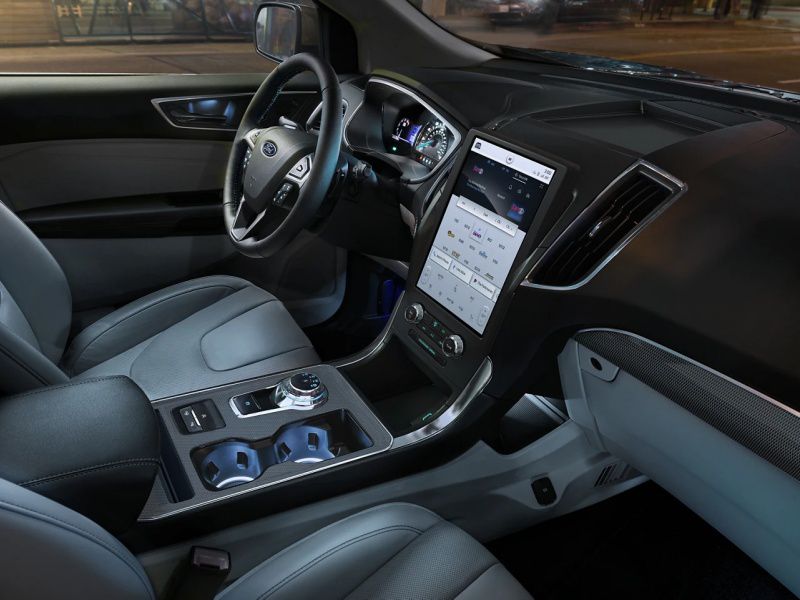
Photo by Ford
Powertrains
The powertrain differences between the Ford Edge and Hyundai Santa Fe point out the differences in philosophy between the two crossovers. The Ford Edge is pretty single-minded about powertrains. It offers a choice, but the vast majority of Edges have the 2.0-liter turbocharged direct-injection inline 4-cylinder mated to an 8-speed automatic transmission. It delivers 250 horsepower and 275 lb-ft of torque. All Edge trims have that engine with the exception of the performance-minded Edge ST. It has a 355-horsepower 2.7-liter turbocharged V6 that drives all four wheels via a 7-speed automatic transmission. The Hyundai Santa Fe is more ecumenical about its powertrain offerings. The standard engine is a naturally aspirated 2.5-liter 4-cylinder engine delivering 191-horsepower. Teamed with an 8-speed automatic transmission, it drives either the front or all four wheels. A turbocharged 2.5-liter 4-cylinder is available in the Limited and Calligraphy trims. It offers 277 horsepower, and it is combined with an 8-speed wet dual-clutch transmission. Santa Fe hybrid models use a 1.6-liter turbocharged 4-cylinder plus two electric motors. The hybrids offer 225 total horsepower.
: Hyundai Santa Fe
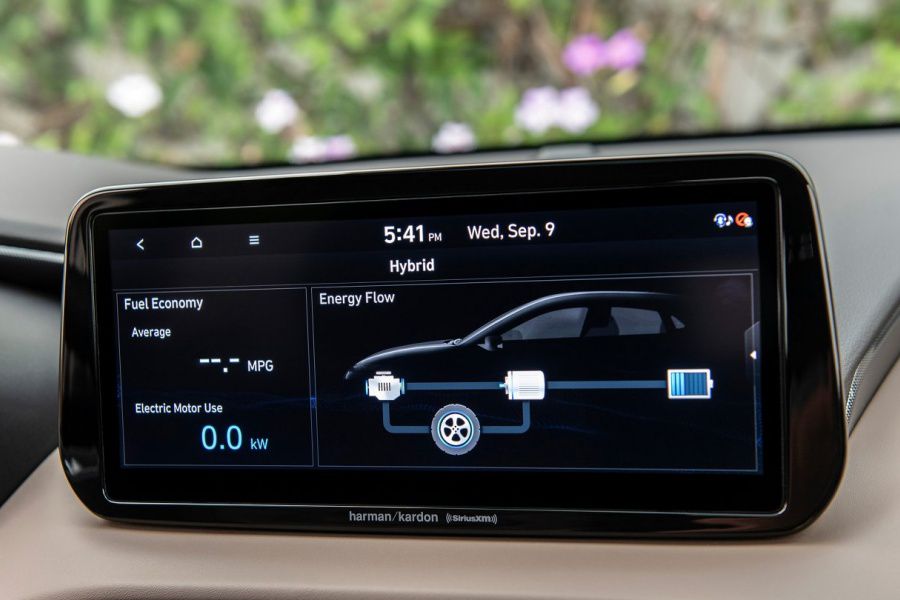
Photo by Hyundai
Driving Impressions
Both the Hyundai Santa Fe and Ford Edge offer good performance and a comfortable ride. With the exception of the Edge ST, neither is especially sporty. Instead, performance and handling are similar to other crossovers in the segment. The Edge ST with its 335 horsepower turbocharged V6 delivers the most driving enjoyment. It is fitted with a responsive 7-speed automatic transmission and several other performance tweaks. The Santa Fe Limited and Calligraphy trims are the closest thing Hyundai offers to the Edge ST. They feature the 277-horsepower turbocharged 4-cylinder engine, but the added horsepower is employed to enhance their luxury feel, not turn them into sports models. Some Limited and Calligraphy buyers might not appreciate the dual-clutch automatic that functions a bit differently from a conventional automatic. But with any of the Santa Fe’s three powertrains, drivers will experience smooth, effortless cruising and a quiet, comfortable ride.
: Ford Edge
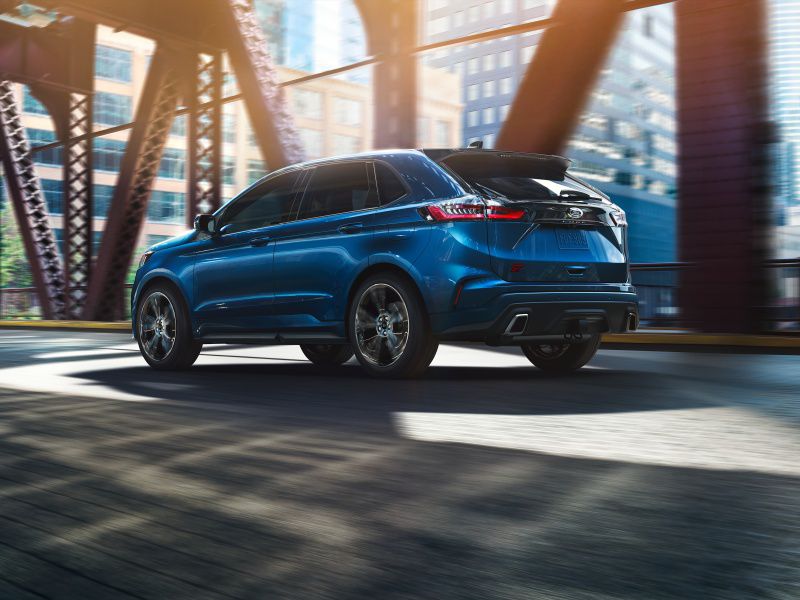
Photo by Ford
Safety and Driver Aids
Both vehicles offer impressive arrays of active and passive safety systems. The Ford Edge offers Ford Co-Pilot360 safety and driver assistance technology standard on all Edge models. It includes automatic high-beam headlights, blind-spot warning with cross-traffic alert, lane-keeping assistance, pre-collision automatic braking with pedestrian detection, and a rear-view camera system. An optional package adds adaptive cruise control, evasive steering assist and built-in navigation with live traffic information and predictive destinations. The Hyundai Santa Fe answers with an extensive number of driver aids and safety systems of its own. Those systems were significantly enhanced for the 2021 model year with the addition of cyclist and junction-turning detection as part of its collision-avoidance system. The safety array also includes lane-following assist and navigation-based smart cruise control, which uses map data to anticipate corners and slow the vehicle if necessary.
: Hyundai Santa Fe
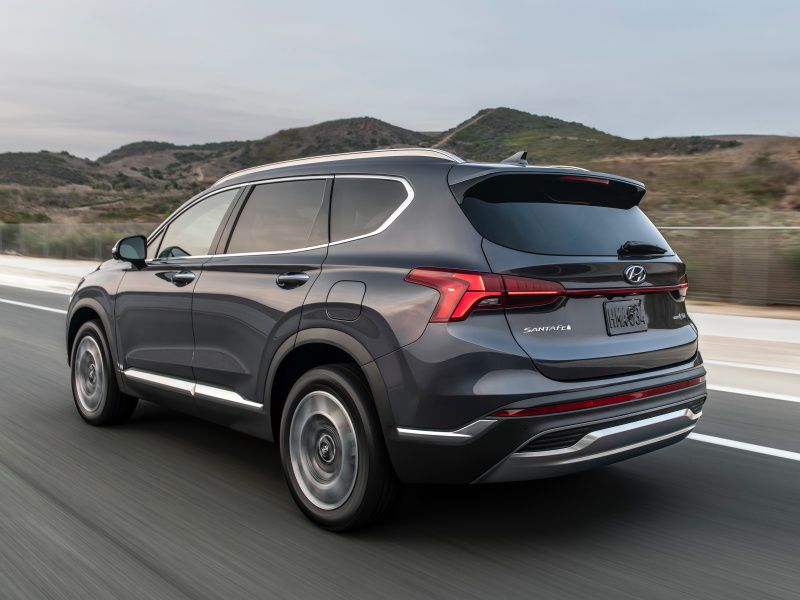
Photo by Hyundai
Interior Space and Cargo Carrying Capacity
By refusing to jam a third row into the Edge and Santa Fe, Ford's and Hyundai's engineers were able to create gigantic rear cargo areas in both vehicles, plus a significant amount of interior space overall. The Edge has 114 cubic feet of passenger volume and the Santa Fe has 111 cubic feet, so no one will feel cramped. The Edge has a massive 39.2 cubic feet of cargo space behind the rear seat. With the rear seatback folded, the cargo space grows to 73.4 cubic feet. Cargo space in the Santa Fe isn’t quite as large but it is still impressive. Its cargo area of 36.4 cubic feet is more than 10 cubic feet larger than that of the Jeep Cherokee and almost six cubic feet larger than the Chevrolet Blazer. With its rear seatbacks folded, the usable cargo space in the Santa Fe is 72.1 cubic feet, within a cubic foot or so of the Edge.
: Ford Edge
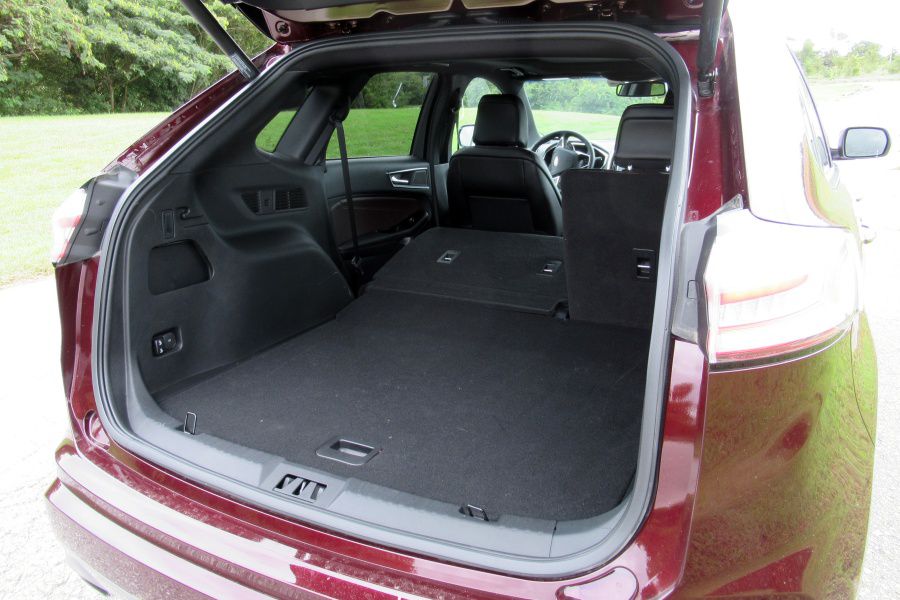
Photo by Brady Holt
Trim Levels
Both the Ford Edge and Hyundai Santa Fe offer a variety of trims and options that allow buyers to customize their vehicles to their liking. The Edge is available in five different trim configurations – SE, SEL, ST-Line, Titanium, and ST. Both front-drive and all-wheel-drive versions are offered in each trim level with the exception of the ST, which is all-wheel drive. Even the base Edge SE is well equipped, including the big touchscreen interface. The SEL has better seating, and the ST-Line offers sporty looks without the ST’s price. The Titanium trim is for luxury, and the ST is the performance Edge. Hyundai offers the conventional 2021 Santa Fe in four trim levels: SE, SEL, Limited, and Calligraphy. The Santa Fe’s hybrid powertrain, something not available in the Edge, is offered in Blue, SEL, and Limited trims. Front drive is the standard configuration on the conventionally powered Santa Fes with all-wheel drive optional. The hybrids are all-wheel drive.
: Hyundai Santa Fe
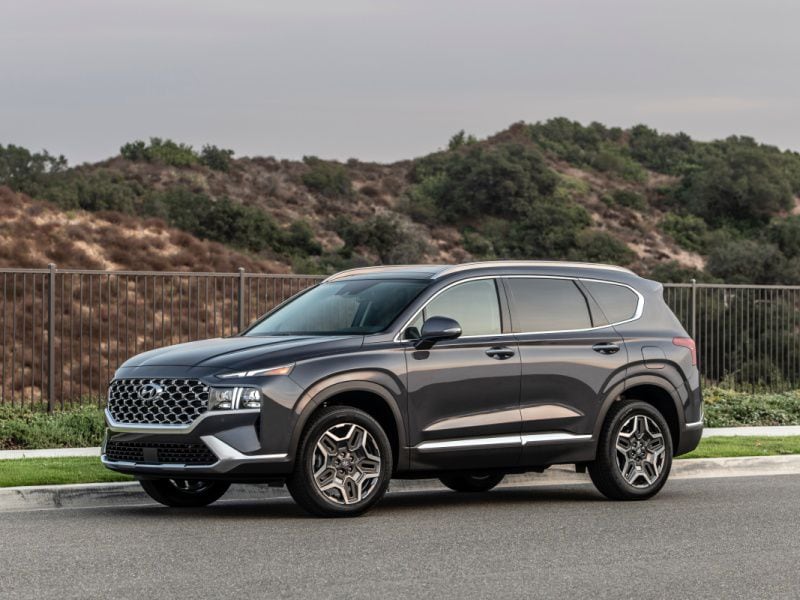
Photo by Hyundai
Pricing and Value
Both models offer good value in the segment. But in many instances, the Santa Fe is priced a bit lower than the Edge. The base Edge SE has a suggested price of right around $33,000, which is a solid value for a huge infotainment screen and a wealth of standard safety technology. The Santa Fe SE trim has an 8-inch touchscreen versus the Ford’s 12-inch screen, but it starts at less than $30,000. The Santa Fe’s mid-range models also have somewhat lower prices than the mid-line Edges. The Edge ST-Line has a suggested price a bit under $40,000, about the same as the Santa Fe Limited.. The Santa Fe Calligraphy is the top-of-the-line model with an MSRP around $45,000, while the Edge Titanium bases about $2,000 less but offers less horsepower. The base Santa Fe Hybrid Blue trim starts at around $35,000. The Edge ST has a suggested price of less than $45,000.
: Hyundai Santa Fe
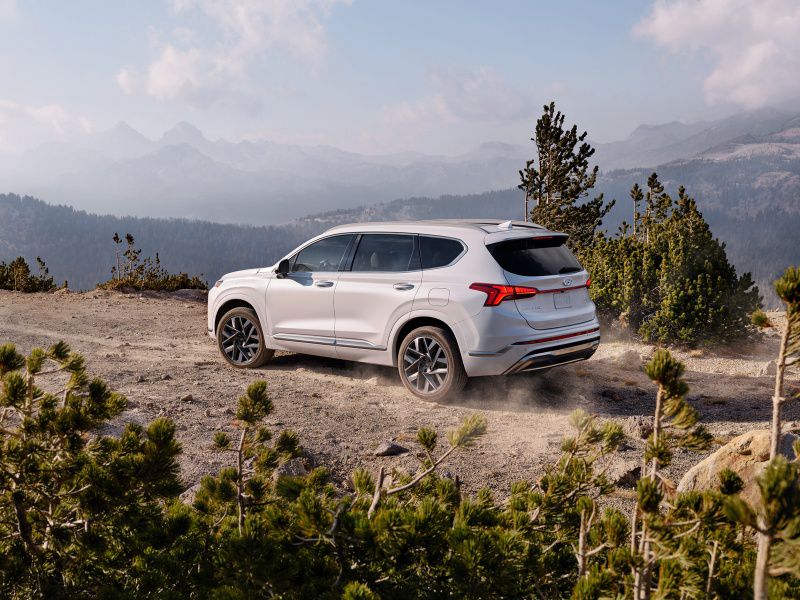
Photo by Hyundai
The Winner
As you’ve noticed, this very close comparison. Both vehicles have their strong suits, and each offers features the other model doesn’t. If you want hybrid power, the Santa Fe is your only choice. If you want a performance model, the Edge is your best option. That said, amid the mid-size crossover class, the two models are very evenly matched. The Edge scores major points with its ultra-large infotainment screen and greater standard horsepower. The Hyundai counters with somewhat lower base prices, an excellent quality record, and a longer warranty. In a segment where looks are so important, you might make your decision based on which one is more attractive to you. And we won’t presume to impose our taste on you there. But for what it brings to the table in this tight race, the winner is the 2021 Ford Edge.
: Ford Edge
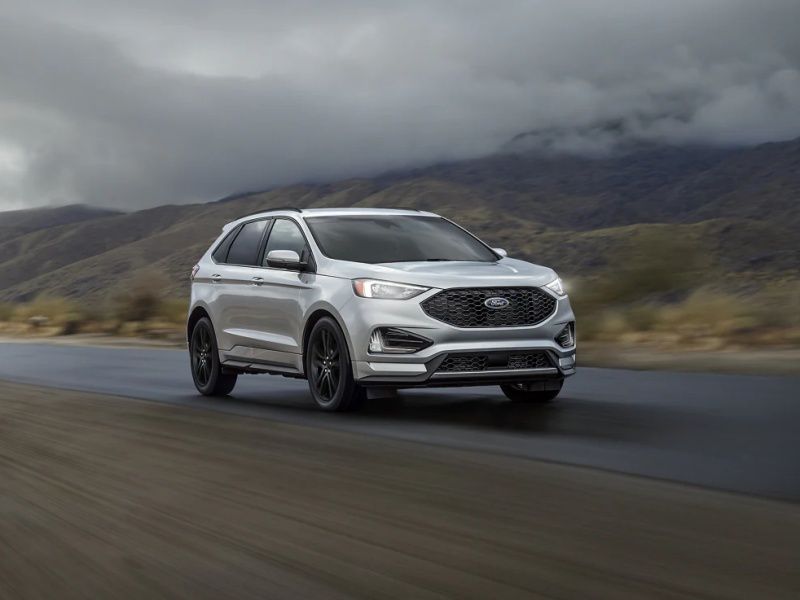
Photo by Ford